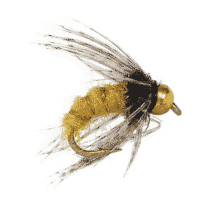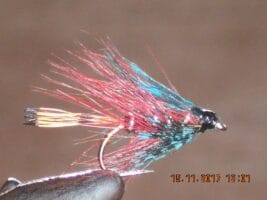Your cart is currently empty!
Caddis Soft Hackle Nymph Fly
This sophisticated pattern incorporates precise material ratios and specialized construction techniques that create an extraordinarily effective subsurface presentation.
Description
The Caddis Soft Hackle Nymph fly represents the pinnacle of aquatic insect imitation, developed through extensive observation of natural caddis behavior and movement patterns. This sophisticated pattern incorporates precise material ratios and specialized construction techniques that create an extraordinarily effective subsurface presentation. The design’s success lies in its ability to trigger both opportunistic and selective feeding responses across various water conditions and seasonal patterns.
Innovative Material Integration and Performance Enhancement
Material Science Applications:
- Chemically sharpened Japanese hooks for instantaneous penetration
- Precision-machined tungsten beads with calculated weight-to-size ratios
- Genetically selected dry fly hackle fibers for optimal movement characteristics
- Proprietary dubbing blends incorporating UV-reactive synthetic materials
- Micro-fine wire ribbing for enhanced durability and segmentation
- Advanced synthetic flash materials for targeted attraction
- Specialized natural fur dubbing for translucent effects
- Premium grade hackle stems for consistent performance
- High-tensile strength synthetic fibers for reinforcement
- Quality-controlled material preparation protocols
Biomechanical Design Elements
Movement Dynamics:
- Calculated fiber length-to-hook-gap ratios
- Engineered hackle stem flexibility coefficients
- Precision-tapered body profiles
- Strategic weight distribution points
- Balanced material density gradients
- Controlled buoyancy characteristics
- Enhanced strike trigger mechanisms
- Optimized hook penetration angles
- Specific color pattern distributions
- Size-matched proportional scaling
Advanced Water Column Tactics
Deep Water Methodology:
- Precision depth control techniques
- Current velocity compensation
- Structure approach protocols
- Depth maintenance systems
- Strike indication enhancement
- Pattern movement variations
- Recovery position optimization
- Multiple rig configurations
- Line control refinement
- Drift speed management
Film Zone Specialization:
- Surface film penetration techniques
- Emerging pupa simulation
- Suspended drift protocols
- Current break exploitation
- Edge water presentation
- Visual strike detection
- Pattern movement control
- Depth transition methods
- Speed control variations
- Strike zone coverage
Seasonal Pattern Optimization
Spring Emergence Tactics:
- Temperature-based presentation adjustments
- Pre-hatch positioning strategies
- Post-runoff clarity adaptations
- Morning emergence techniques
- Evening activity patterns
- Temperature transition protocols
- Hatch-matching methodologies
- Pattern size selection criteria
- Color variation strategies
- Multiple rig configurations
Summer Performance Enhancement:
- Dawn patrol methodologies
- Dusk presentation techniques
- Deep run strategies
- Fast-water tactics
- Temperature compensation
- Light penetration adaptation
- Oxygen level assessment
- Feeding behavior matching
- Pattern rotation protocols
- Presentation speed adjustment
Technical Water Applications
Tailwater Specialization:
- Clear water presentation methods
- Selective trout approach tactics
- Micro-current reading techniques
- Pattern size reduction protocols
- Leader length optimization
- Tippet diameter selection
- Strike detection refinement
- Recovery position selection
- Follow-through protocols
- Multiple rig considerations
Mountain Stream Tactics:
- Pocket water presentation methods
- Boulder field navigation
- Current seam exploitation
- Structure targeting protocols
- Depth variation techniques
- Pattern size adaptation
- Color selection criteria
- Retrieve speed adjustment
- Strike zone identification
- Recovery position optimization
Environmental Adaptation Protocols
High Water Tactics:
- Weight compensation methods
- Pattern size modifications
- Color selection refinement
- Presentation speed adaptation
- Depth control protocols
- Structure approach strategies
- Safety consideration systems
- Recovery technique modification
- Pattern rotation strategies
- Leader system adaptation
Low Light Operations:
- Enhanced visibility patterns
- Flash material integration
- Contrast enhancement methods
- Presentation modifications
- Depth adjustment protocols
- Strike detection systems
- Pattern size optimization
- Color brightness adaptation
- Recovery position modification
- Multiple pattern approaches
Advanced Rigging Specifications
Leader Engineering:
- Competition-grade leader systems
- Specialized tippet selection
- Strategic dropper placement
- Weight distribution calculations
- Tangle prevention protocols
- Line diameter progression
- Knot selection optimization
- Breaking strength analysis
- Visibility management
- Leader turnover dynamics
Terminal Tackle Optimization:
- Tippet ring application methods
- Dropper spacing calculations
- Pattern combination selection
- Weight placement strategies
- Line control enhancement
- Strike detection systems
- Leader balance considerations
- Casting adaptation methods
- Depth control mechanisms
- Pattern rotation protocols
The Caddis Soft Hackle Nymph represents the perfect fusion of traditional fly tying artistry and modern material science. Its sophisticated design incorporates precise engineering principles with time-tested fishing techniques, creating a pattern that consistently produces results across varying conditions. Whether targeting selective trout during specific hatches or searching for opportunistic feeders in technical water, this pattern delivers exceptional performance through its carefully calculated design elements and versatile presentation capabilities.
Additional information
| Hook size | 10, 12, 14, 16, 18, 20 |
|---|---|
| Hook type | Barbed Hooks, Barbless Hooks |







